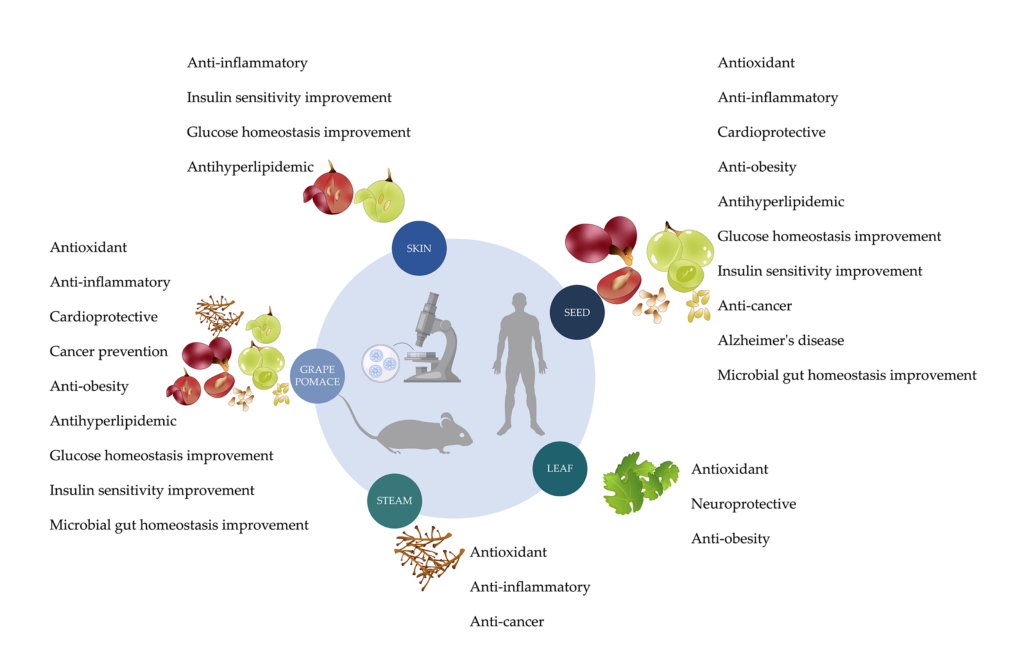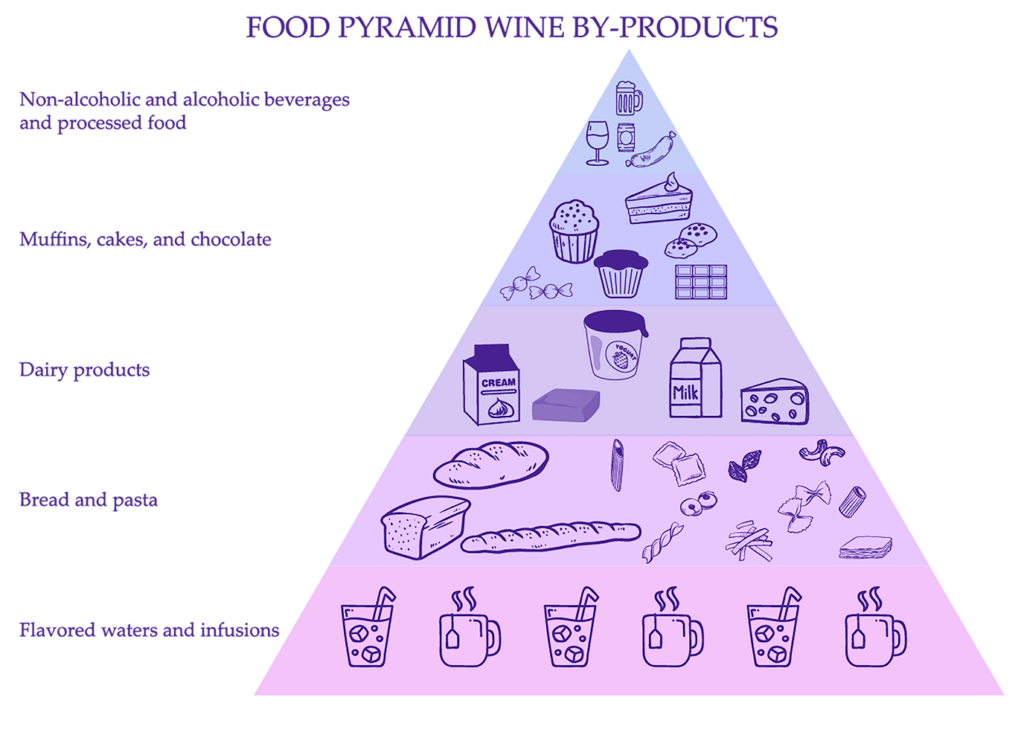By Raúl Ferrer-Gallego and Paula Silva
The total global production of wine in 2021 was estimated around 250 million hectoliters [1]. The 30% of the total quantity of vinified grapes corresponds to wine by-products that represents nearly 20 million tons, which 50% corresponds to the European Union. Wine by-product have been used for different purposes, in agriculture, cosmetics, pharmacy, biorefinery, feed and for food industry [2-8]. The main waste streams with food interest are grape pomace (GP) and wine lees [9]. GP is the residue originated after the pressing of red and white grapes to produce must or wine. It is composed by the stems, skins, and seeds. During the vinification process, a large amount of GP is generated with valuable recovery because constitutes an important source of value-added products such as phenolic compounds, mainly flavonoids, phenolic acids, and stilbenes [10, 11]. The solid deposits formed at the bottom of the tanks mainly consist of yeasts and bacteria, carbohydrates, polyphenols, lignin, proteins, metals, salts, and organic acids (e.g., tartrates). The liquid phase is rich in ethanol and organic acids (tartaric acid, lactic acid, and acetic acid) and usually is distilled to recover ethanol and produce distilled beverages [12]. The clusters or grape stems constitute a residue that can be used as a source of astringent compounds, represented mainly by proanthocyanins. Wine lees have also important antioxidant and biological properties [13]. All these compounds should be reused for food industry and enriching products included int the Mediterranean diet (MD). It is well-known that MD has a low environmental impact, since it is mainly a plant-based diet with low consumption of animal products, a small water footprint and low greenhouse gas emissions [14]. Removing wine industry by-products is a suitable strategy to recover bioactive compounds (mainly polyphenols) from GP and to reduce the environmental impact of these industrial wastes.
MD is based on the traditional foods eaten by people living in the Mediterranean region, such as fruits, vegetables, beans, nuts, seafood, olive oil, and dairy products with perhaps a glass of wine, and inversely associated with consumption of ultra-processed foods and lower free sugar intake [15]. Consumers are increasingly looking for solutions to improve health and prevent chronic diseases. This is one reason why everyone is talking about MD nowadays. In fact, according to U.S. News & World Report 2020, the MD is the number one overall diet for the third consecutive year. The main reason for this success is the great number of evidence achieved by scientists showing that MD is one of the healthiest dietary patterns with several benefits regarding longevity and chronic diseases [15]. Recently, MD has been promoted as a useful tool to reduce body weight, which could also explain the current interest for this diet. However, it remains uncertain what consumers understand about and expect from MD. Knowing that consumers quickly quit from diets because the effort required is perceived as outweighing the benefits, it is important that physicians, nutritional authorities, scientists, educators, cooks, and communicators work together to convince consumers that MD is not just something that can be done for a short time to be healthier [16] and/or to lose weight, but it is a lifestyle that must be adopted forever.
Figure: Valuable applications of wine by-products on the food pyramid of the Mediterranean Diet.
The global wine industry has been constantly increasing over the last decades. However, the wine industry results in significant amounts of by-products, which have negative consequences for the environment. This practice is not acceptable and must be stopped. The urgency for sustainability within the wine industry has turned the research interests to investigate the management of wine by-products from another perspective, for example, by adapting more profitable options and using wine by-products to produce foods. The current review is of the utmost importance and aims to indicate alternative solutions for the upgrading of processing wine by-products, as well as indicating their industrial potential in the food industry. The goal is to support the scientists, professionals, and enterprises that aspire to develop high-scale industrial applications. It focuses on the most recent advances in the area while also analyzing the potential of already produced foods and their potential health benefits. The review fills the existing gap in the current literature by providing a direction for all the involved stakeholders, professionals, and technologists who are active in the field and are trying to optimize the wine industry’s performance and reduce its environmental impact.
The optimization of wine waste management, the improvement of enriched foods and drinks, the verification of some related health benefits of polyphenols and finally its inclusion on the Mediterranean markets leads the purpose of this review. The objective is to review the health benefits of bioactive compounds found in winemaking by-products and their application to produce innovative food products that can be included on MD. A sustainable use of the enrichment of MD products from GP to promote new foods attributes including health and nutritional benefits, environmentally friendly food, and socially responsible food is reported here.
Wine production generates a huge amount of residues, such as grape marc, vine shoots, stalks, pomace, and wine leaves. Wine by-products have high potential as food ingredients since they facilitate the sustainability increase of the wine industry by reusing a product that is usually considered waste. The taste and attractive color of wine by-products provide opportunities for the development of new foods with high nutritional value and health benefits and might even be considered natural alternatives to traditional synthetic additives. Wine by-products are, therefore, an interesting opportunity for adding value by recycling a waste stream and representing food ingredients with high contents of polyphenols. The current review handles of wine by-products include management practices that lead to the diminution of their pollution load by getting advance of their content in valuable ingredients (e.g., antioxidants). These practices have a positive ecological and economic impact on the wineries.

Figure: Wine by-products bioactivity showed by pre-clinical and clinical trials.
Vine roots, seeds, and leaves have been widely used since ancient times as food preservatives and flavoring agents, but also as part of the traditional medicine in various cultures. Their antimicrobial, antioxidant, anti-inflammatory and anticancer effects rely on their high polyphenols content. Many of these compounds are also present in the wine by-products and could be used in food industry to prevent microbial spoilage, product safety and prolonged shelf life, and potential health effects for the consumers. In this review we showed that the enrichment of food with wine industry by-products has several health benefits, which have been proved by several in vitro, in vivo, and clinical studies. Current research has demonstrated that foodstuff produced with wine by-products or their extracts exert antioxidant, anti-inflammatory, cardioprotective, and anticancer actions in vitro and in vivo, which attest to the health benefits of their intake. Pre-clinical studies show that wine by-products have the potential to scavenge free radicals and modulate the inflammatory process. They inhibit the key inflammatory mediator, NFκB, and proinflammatory enzymes such as COX-2, MAPK, and protein kinase-C. They exhibit mostly a mitigating effect on inflammatory cytokines and increase anti-inflammatory cytokines. These foodstuffs represent enormous promise in the prevention of chronic diseases. Understanding the nature of wine by-products compounds, their combinations, and the molecular mechanism of action in eliciting bioactivity is vital. Further pre-clinical, epidemiological, and follow-up studies are thus warranted to explore the maximum nutraceutical potential of wine by-products in food applications.
Nowadays, scientists, politicians, and winemakers talk about sustainability, but the truth is that sustainable practices implementation is very scarce. Using wine by-products to enrich food is an opportunity to improve the economic, social, and environmental dimensions. It is urgent that the scientific community and producers look for more profitable and sustainable options. Sustainability requires the maximum utilization of all raw materials and wine by-products produced and minimum disposal of waste flow. Modern wineries must embrace strategies of management and valorization that allow both the recovery and recycling of valuable ingredients and the creation of new products. The current review fills the gap in transferring knowledge between academia and industry by providing a reference for winemakers, professionals, and producers active in the field, trying to optimize wineries’ performance and reduce their environmental impact. The major goal of this review is to inspire all relevant participants to develop real commercialized applications.
Read all at: Ferrer-Gallego, R., Silva, P., 2022. The Wine Industry By-Products: Applications for Food Industry and Health Benefits. Antioxidants 11, 2025.. doi:10.3390/antiox11102025
https://www.mdpi.com/2076-3921/11/10/2025

Ferrer-Gallego, Oenologist, PhD, is currently working at Department of Ecology, Desertification Research Centre (CIDE-CSIC-UV-GV). His research is focused on the study of the chemical composition and sensory analysis of wine. After working in national and international wine industries, in 2006 he started his scientific career at the University of Salamanca (Spain) in the Research Group of Polyphenols obtaining the PhD Extraordinary Award. The post-doctoral period was carried out at the University of Porto (Portugal) related to the interactions between polyphenols and salivary proteins (https://orcid.org/0000-0002-0301-5334). In 2012, he created ENDEMIC, a personal project to conserve the family vineyards and to elaborate pure organic wines from old vines (http://vinonaturalendemic.com/). Certainly, the relationship between grapes, wine composition and quality are his line of action in the Wine Science field. In 2016 was incorporated to Wine Technology Center (VITEC). His contributions to the society are related to the wine sector and demonstrated by the transfer of knowledge of new processes, products, and services to wineries and auxiliary industry. This transference knowledge to wine industry was made ad hoc for private companies and institutions. Raul Ferrer-Gallego presents 38 original indexed articles with demonstrated relevance for wine science and great impact in the understanding the relationships between polyphenols of wine, salivary proteins, and the sensory perception.

Paula Silva is Assistant Professor in the Laboratory of Histology and Embryology, Department of Microscopy, in the Institute of Biomedical Sciences Abel Salazar (ICBAS) of University of Porto (UPorto) and researcher at iNOVA Media Lab, ICNOVA of NOVA University Lisbon. Teaching experience covers: Histology and Embryology (Human and Comparative) and Science Communication. Director of the continuing training course “Science communication – Life and health sciences” (6ECTS). She obtained her PhD in Biomedical Sciences in UPorto. Paula Silva presents in her CV 34 original articles published in journals indexed in the Science Citation Index (SCI), 1 book chapter, participation in some I&DT projects, and numerous works in many national and international congress. At present, her main research topic is the influence of the Mediterranean Diet on the prevention of chronic diseases, particularly, neurodegenerative diseases, and health science communication. Editor of the Science & Wine blog (http://science-and-wine.com/).
References
- OIV. https://www.oiv.int/en/statistiques/ (accessed 13/07/2021).
- Aliaño-González, M.J.; Gabaston, J.; Ortiz-Somovilla, V.; Cantos-Villar, E. Wood waste from fruit trees: biomolecules and their applications in agri-food industry. Biomolecules 2022, 12 (2).
- Câmara, J.S.; Lourenço, S.; Silva, C.; Lopes, A.; Andrade, C.; Perestrelo, R. Exploring the potential of wine industry by-products as source of additives to improve the quality of aquafeed. Microchem J 2020, 155.
- Galanakis, C.M. Handbook of grape processing by-products: sustainable solutions. Academic Press: 2017.
- Pedroza, M.A.; Salinas, M.R.; Alonso, G.L.; Zalacain, A. Oenological applications of winemaking by-products. In Handbook of Grape Processing By-Products, Elsevier: 2017; pp 215-232.
- Shrikhande, A.J. Wine by-products with health benefits. Food Res Int 2000, 33 (6), 469-474.
- Ferreira, S.M.; Santos, L.A Potential valorization strategy of wine industry by-products and their application in cosmetics—case study: grape pomace and grapeseed. Molecules 2022, 27 (3).
- Hassan, Y.I.; Kosir, V.; Yin, X.; Ross, K.; Diarra, M.S. Grape pomace as a promising antimicrobial alternative in feed: a critical review. J Agric Food Chem 2019, 67 (35), 9705-9718.
- Tapia-Quirós, P.; Montenegro-Landívar, M.F.; Reig, M.; Vecino, X.; Cortina, J.L.; Saurina, J.; Granados, M. Recovery of polyphenols from agri-food by-products: the olive oil and winery industries cases. Foods 2022, 11 (3).
- Beres, C.; Costa, G.N.S.; Cabezudo, I.; da Silva-James, N.K.; Teles, A.S.C.; Cruz, A.P.G.; Mellinger-Silva, C.; Tonon, R.V.; Cabral, L.M.C.; Freitas, S.P. Towards integral utilization of grape pomace from winemaking process: A review. Waste Manag 2017, 68, 581-594.
- Chowdhary, P.; Gupta, A.; Gnansounou, E.; Pandey, A.; Chaturvedi, P. Current trends and possibilities for exploitation of Grape pomace as a potential source for value addition. Environ Pollut 2021, 278.
- Pérez-Bibbins, B.; Torrado-Agrasar, A.; Salgado, J.M.; Oliveira, R.P.D.S.; Domínguez, J.M. Potential of lees from wine, beer and cider manufacturing as a source of economic nutrients: An overview. Waste Manag 2015, 40, 72-81.
- Jara-Palacios, M.J. Wine lees as a source of antioxidant compounds. Antioxidants 2019, 8 (2).
- Tilman, D.; Clark, M., Global diets link environmental sustainability and human health. Nature 2014, 515 (7528), 518-522.
- da Rocha, B.R.S.; Rico-Campà, A.; Romanos-Nanclares, A.; Ciriza, E.; Barbosa, K.B.F.; Martínez-González, M.Á.; Martín-Calvo, N. Adherence to Mediterranean diet is inversely associated with the consumption of ultra-processed foods among Spanish children: The SENDO project. Public Health Nutr 2021, 24 (11), 3294-3303.


